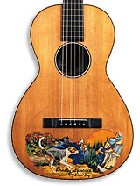
It’s not absolutely certain when the artist-model guitar debuted.
Guitarmaking has a long history of artist “endorsements,” as in, “Segovia plays a Hausser so I want one, too.” Late-19th-century makers used testimonials to promote various models, often by professionals. And special guitars have always been made to artist specs. But these are not quite the same thing.
The honor for first creating a model named for a popular artist may go to Harmony, which rolled out a line of Roy Smeck Vita instruments in the late 1920s. However, for sure the first modern media-driven guitar was the Supertone Bradley Kincaid Houn’ Dog, built by Harmony and sold primarily through Sears beginning in 1929 – the first “cowboy” guitar.
The Houn’ Dog reflects a fascinating confluence of developments on the eve of the Great Depression. William Bradley Kincaid (1895-1989) was born in Kentucky and learned to play guitar on a box his father had traded a canine for, hence the guitar’s nickname. Kincaid became a folk singer, known as the Kentucky Mountain Boy, and earned a sociology degree from YMCA College, in Chicago. In 1926, he debuted on Sears’ WLS National “Barn Dance” radio show, where he became a star. Kincaid was an avid song collector, and in 1928 published his immensely popular My Favorite Mountain Ballads And Old Time Songs. His recordings were also hits and included such classic songs as “Barbara Allen,” “The Legend of the Robin’s Red Breast,” and “The Wreck of the Number Nine,” among many others.
In a stroke of brilliant crossmarketing, Sears, which owned not only WLS but also Harmony and sold radios, record players, and records, had Harmony create the Supertone Bradley Kincaid Houn’ Dog. It was sold with a copy of Kincaid’s songbook, and a pick. You could buy a Sears radio, hear Bradley croon, buy a Sears record player and some Kincaid records, enjoy him some more, then get a Kincaid guitar and book, learn his songs, and play them yourself. All from Sears! (Several versions of the Houn’ Dog were sold through distributors other than Sears; these would not have the Supertone label.)
Zero out any perception of this guitar as one of those cheap birch units with the cowboy stencil. The Bradley Kincaid Houn’ Dog was a fine little 12″ standard-sized guitar with a solid spruce top and mahogany body and set mahogany neck with a nice V profile. The top and soundhole were bound in celluloid inlay and featured a large mountain hunting scene decal (called “decalomania”) on the belly. The first Houn’ Dogs had white celluloid and colored wood marquetry inlay on the top; later models had black-and-white celluloid strips. The fingerboard was ebonized hardwood with pearl dot inlays. The pin bridge was rosewood, and the ladder-braced guitar was intended for steel strings.
The Houn’ Dog was a well-made little guitar that sounds swell, especially as a fingerstyle instrument. It responds nicely when strung with light-gauge strings, like a silk-and-steel. These were mass-made guitars. But that doesn’t translate to junky, as it would later. The V-shaped neck is thick but comfortable. Essentially, the Kincaid reflected the tail-end of Harmony’s early-style guitars, before the switch to emphasizing archtops and the poly or stencil flat-tops we usually associate with the brand.
Bradley Kincaid left WLS in 1930, although the Houn’ Dog was produced and sold (primarily) through Sears until 1931, to be supplanted by bigger star power in the person of Gene Autry, whose first guitar was pretty much the same as the Houn’ Dog.
Kincaid went on to perform in Nashville on the Grand Ole Opry in the mid 1940s, then bought WWSO radio in Springfield, Ohio, and continued to play folk festivals into the early ’60s. The guitar bearing his name is both interesting history and a cool little picker.
Photo: Michael Wright.
This article originally appeared in VG‘s Jan. ’03 issue. All copyrights are by the author and Vintage Guitar magazine. Unauthorized replication or use is strictly prohibited.



